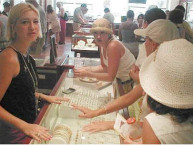Peridot
The trend for this year seems to be colorful, vibrant gemstones that are unusual and eye-catching.  Many jewelers in the Caribbean are reporting people shopping heavily for Peridot. Once considered a gemstone for the connoisseur, fine quality Peridot is now more plentiful thanks to a recent large discovery. In years past consumers looking for Peridot had only a few pieces to choose from, settling for less than wonderful gems lead to disinterest by consumers and designers. With the newer large supply of this gemstone readily available, outstanding quality Peridot are available thru fine jewelers.
Many jewelers in the Caribbean are reporting people shopping heavily for Peridot. Once considered a gemstone for the connoisseur, fine quality Peridot is now more plentiful thanks to a recent large discovery. In years past consumers looking for Peridot had only a few pieces to choose from, settling for less than wonderful gems lead to disinterest by consumers and designers. With the newer large supply of this gemstone readily available, outstanding quality Peridot are available thru fine jewelers.
Peridot is the gem variety of olivine. It’s colors can range from greenish yellow, yellow-green, strongly yellowish green, yellowish green, slightly yellowish green, to green. The finest examples of this gemstone has an absence of the yellow modifier. Sometimes in dim light it would appear to be a fine emerald, hence its nickname— “Evening Emerald.”
When looking for Peridot gemstones first observe the color. Check the color in a variety of lighting conditions. The finest stones will be predominantly green, with as little yellow as possible. You will want a well balanced cut. Smaller stones should be eye clean, while larger stones often have eye visible inclusions. Under the microscope a gemologist will see “lily Pad type” inclusions. This is a characteristic of peridot and aids in identification. The strong double refraction is an important distinguishing mark, in very thick stones the doubling of the edges can be seen with the naked eye. Many feel this helps to make the stone a “brighter” stone.
Generally due to its color many designers prefer to set this gemstone in Gold. The preferred cuts seem to be table and emerald cuts, however there is a new interest in the past few years of having this gemstone cut into unusual shapes. It is very rare to find cat’s eye peridot or star peridot.
“Is Peridot a Brittle Stone?”
Compared to some  stones it can be considered brittle. It does not tolerate rough treatment. It has a tendency to abrade at the facet junctures. However as long as the wearer realizes it is a somewhat delicate stone, it can last for generations. Treat it as you would a fine designer dress, only for special occasions, but you can be secure in the knowledge that it will be impressive!
stones it can be considered brittle. It does not tolerate rough treatment. It has a tendency to abrade at the facet junctures. However as long as the wearer realizes it is a somewhat delicate stone, it can last for generations. Treat it as you would a fine designer dress, only for special occasions, but you can be secure in the knowledge that it will be impressive!
As with all gems, protect peridot from scratches and sharp blows. Also avoid large temperature changes (such as leaving it be a heater vent or in a hot car). Do not clean peridot in a home ultrasonic cleaner.
The largest cut peridot weighs 310 ct. and was found on the island of St John. It is at present in the Smithsonian Institute in Washington D.C. In Russia there are some cut peridots which came out of a meteorite which fell in 1749 in eastern Siberia.
The most important deposits of Peridot are in the Red Sea on the volcanic island of St. John, 188 miles east of Aswan. They have been mined for 3500 years. Beautiful crystals can be found on the walls of cavities of weathering peridot rock. In 1994 a large deposit of peridot was discovered in Pakistan which has stimulated more interest in Fine Peridot. There are also quarries in upper Burma. Less important finds have been in Australia, Brazil, (Minas Gerais) South Africa, the US (Arizona, Hawaii, and New Mexico) and Zaire. In Europe peridot is found in Norway, north of the Nord Fjord.
Peridot is the birthstone for August.
History and Lore of Peridot
The old name, chrysolite was once applied indiscriminately to both peridot and topaz, which caused great confusion, especially since Peridot came from the Red Sea island of Zebirger, which was identified with the legendary topaz isle, Topazin. In fact, in some ancient writings, topaz means peridot. Confused? Your not alone.
Highly valued in ancient times, the stones were once considered more valuable than diamonds. In fact, they were actually used as currency to pay tribute to Egyptian rulers. The ancients of that day believed that peridot could only be found at night, when the stone radiated like the sun. Although it was said to glow, peridot was never mined at night. Instead, the spot where the light appeared was carefully marked, and the diggers would return the next day to unearth the gems.
Peridot was the only gem set in transparent form by the Romans, who wore it for protection against enchantments, melancholy and illusion. Peridot was brought to Europe by the crusaders in the Middle Ages and was often used for ecclesiastical purposes. It was very popular during the Baroque period. During the Middle Ages, knights wore the stone as a means of gaining foresight and divine inspiration. It was also recommended for those who desired eloquence in speech.
Hawaiians believed that peridot gems were actually the tears of their goddess Pele. If you visit the island of Oahu you can actually see whole beaches that are made up of tiny granules of olivine. Imagine how that must look on a moonlit tropical night!
Legend has it that pirates favored peridot to protect them against evil. When the peridot was set in gold it also protected the wearer from terrors in the night.
In ancient times it was credited with wonderful powers. It could drive away evil spirits and spells when attached to the left arm with the hair of a donkey. If the actual peridot stone had an engraving of a donkey it could give prophetic powers, engraved with a vulture and it would control demons.
Peridot held one extremely high distinction in that it was thought to be the “major healing gemstone of fabled Atlantis.” It was thought to stimulate tissue regeneration in the entire body. Many believed that peridot “fine tuned” a wearers mental capacities and would leave him more open to psychic awareness.



